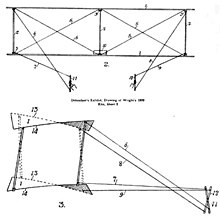The Wright Brothers, Orville and Wilbur, are often described as "the first to fly". They were not - even if you don't count balloons, quite a few people had lifted off Terra Firma in heavier-than-air machines before December 17, 1903. Their real achievement was to engineer the first practical and controllable airplane, and then fly it - in 1905.
Sir George Cayley, 6th Baronet of Brompton, didn't himself fly in his glider. Being a nobleman and memeber of parliament, he had one of his employees fly - his coachman - who promptly resigned, saying that he was employed to drive, not to fly. The picture below shows a replica flying in 1973, since photography hadn't been invented in 1853. His main contribution to aeronautics, is that he was the first to identify the four primary forces acting on an aircraft, that we all learn as student pilots - weight, lift, thrust and drag.
 |
| A replica of Cayley's 1853 design, flown 120 years later |
Otto Lilienthal approached flying in a systematic way, creating a series of gliders that he flew down hills in Germany. His main contribution was to test a series of airfoil shapes, and develop lift tables. His gliders used a bar which he held, and used weight shifting for control - just like a modern hang glider. Unfortunately on 9 August 1896 a sudden wind gust caused his glider to stall, and his weight shifting was insufficient for recovery. He crashed and died.
 |
| Lilienthal flying one his gliders in the late 1890s |
Octave Chanute was a French railway engineer who moved to the USA as a child. He designed many railway bridges and yards throughout the Midwest, but turned as an older man to aviation. He was too old to fly himself, but engaged Augustus M. Herring and William Avery as substituents. His primary contribution to design was the biplane glider, reasoning (based on Lilienthal's tables) that more lifting surface was needed, but the scale could be kept under control by decking the wings. His largest design used 12 wings stacked one on top of the other. His secondary contribution was to act as a kind of manual bulletin board for the science of aviation, informing all the world's pioneers of the discoveries and activities of others in the field.
 |
| Augustus Herring preparing to fly a Chanute "double-decker" glider |
Enter the Wrights. In 1899 Wilbur wrote to the Smithsonian Institute and started a voluminous correspondence with Chanute, gathering and learning from all who had gone before him (most competitors didn't take such a systematic approach). Learning that people knew how to get off the ground, he identified control as the main issue, and had his nearest approach to the "eureka moment" when he conceptualized twisting the Chanute double decker to achieve "wing warping". He built a glider using wing warping, and flew it as a kite that summer - demonstrating that he could control the kite. The Wright's most important contribution was also their first.
 |
| Wilbur Wright's 1899 glider/kite using wing warping |
1 comment:
I love the aviation history posts! Keep up the great job!!
Post a Comment